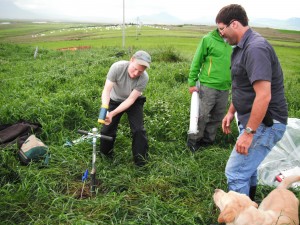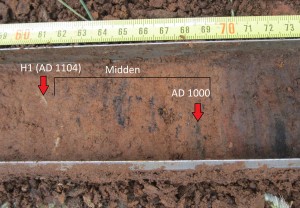This year the team is back for a short summer field season to ask a simple – but important – question: what is the total volume of cultural material accumulated at Viking Age farms in Langholt? Previous work done by the Skagafjörður Archaeological Settlement Survey (SASS) has determined the areal extent of Viking Age farms, but we still don’t know whether some farms are ‘thicker’ than others, meaning they accumulated more refuse over the same amount of time. If we can estimate the volume of cultural deposits and compare them from farm to farm (and from the Viking Age to the Medieval period), we’ll have a better idea of how the landscape was settled and changed over time throughout the region.
Many of the farms in Langholt were occupied from the Viking Age to the 20th century. Sometimes the Viking Age farm is buried deep underneath centuries of cultural deposits. The main types of material we find in farm mounds are architecture and trash: turf and midden. The accumulated material sometimes creates a visible ‘mound’ on the surface – also known as a farm mound. To get information at the bottom of a farm mound, archaeologists have to dig sometimes up to 3 or 4 meters (10 to 13 feet) deep. This summer, the SASS team is using deep coring to efficiently collect basic data about farm mounds with minimal disturbance to the archaeological record. It takes a little elbow grease, but the quality of the data is worth it!
We use tephra layers (ash from volcanic eruptions in Iceland) to helps us date certain deposits. At Kjartansstaðir, for example, underneath 3.5 meters of cultural deposits, we found strips of H1 (dating to AD 1104) and the 1000 layer (dating to around AD 1000) with midden underneath. This gives us a good idea of the depth of the Viking Age farm. Combined with areal extent, we can determine the ‘volume’ of Kjartansstaðir before and after the Viking Age.
So far things are moving on schedule. We hope to survey at least 7 farms before the end of the field season.


